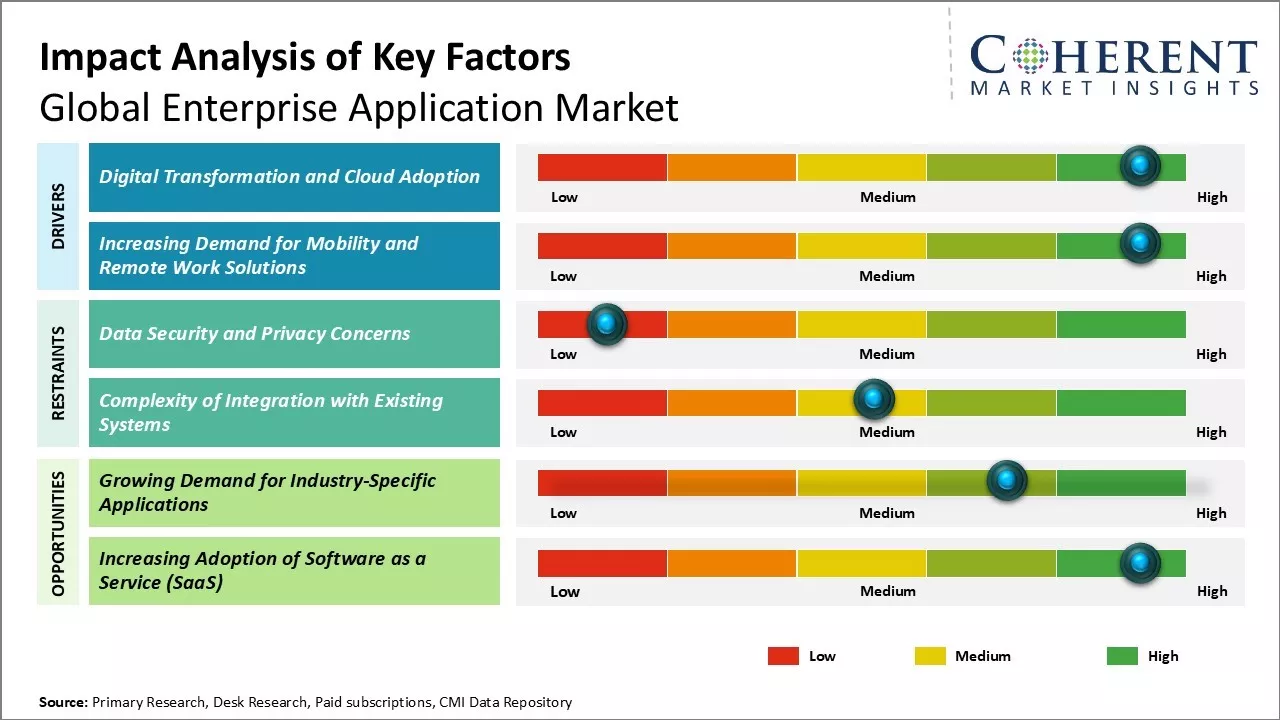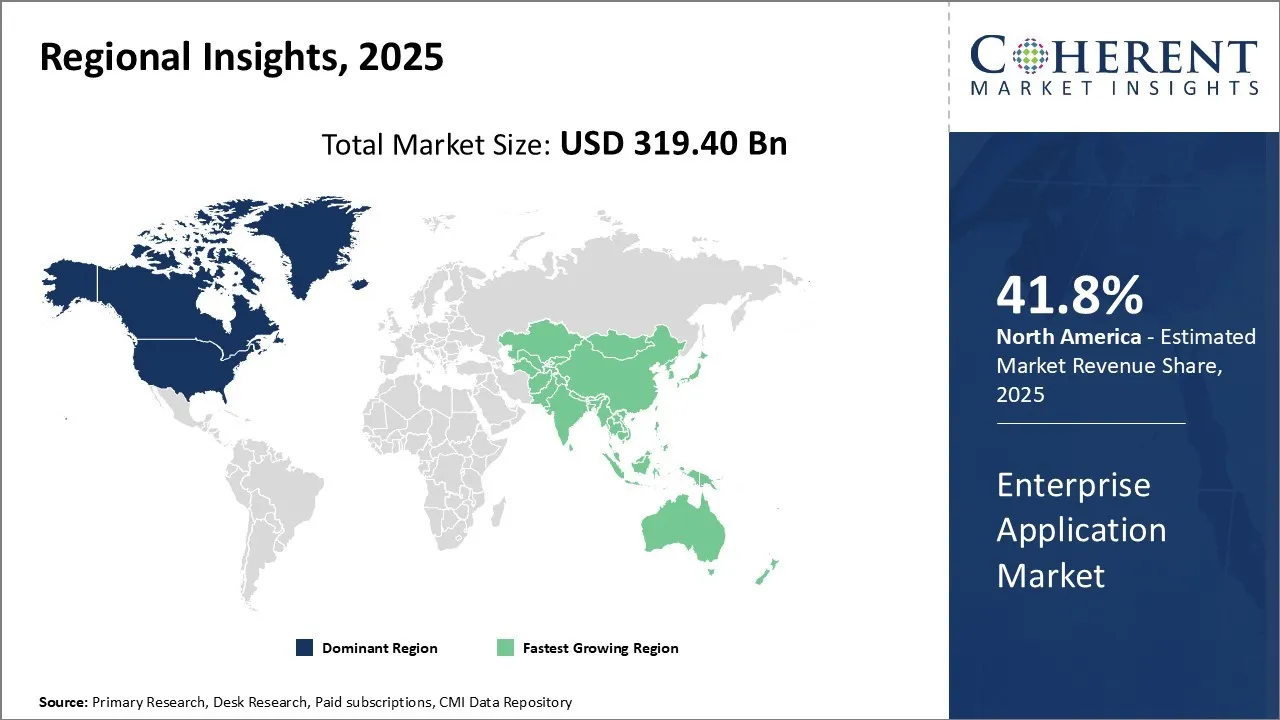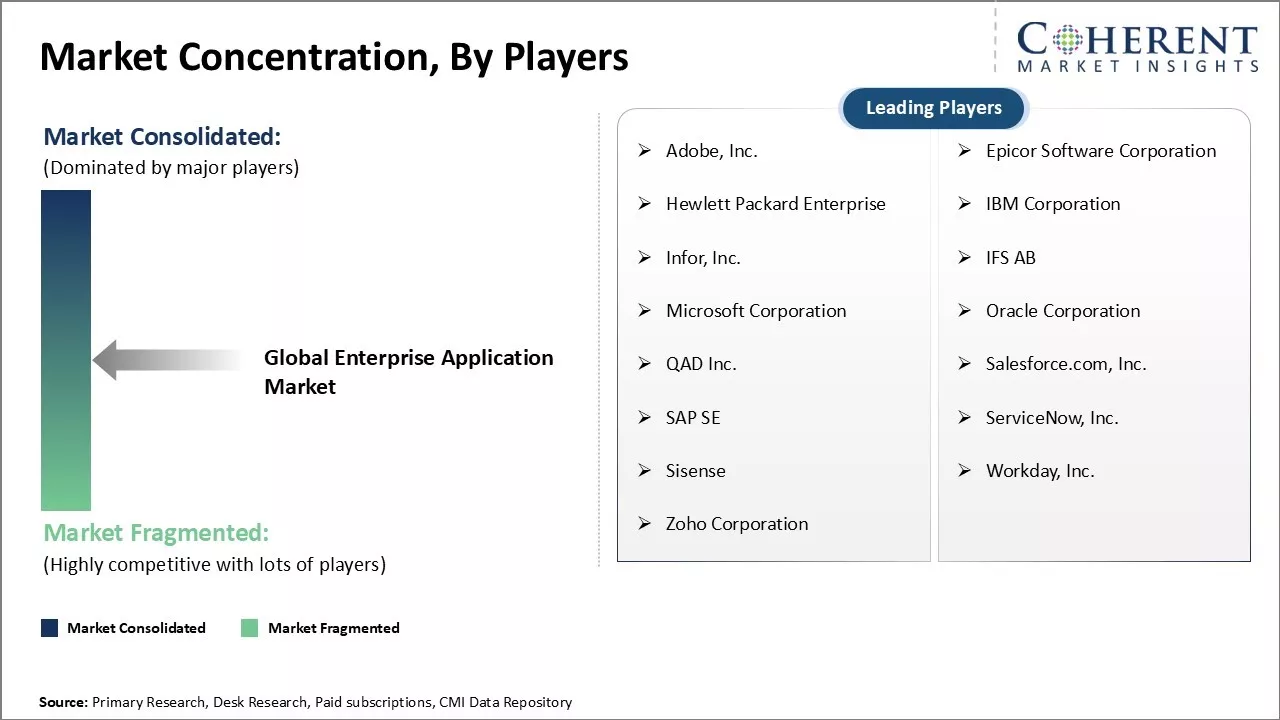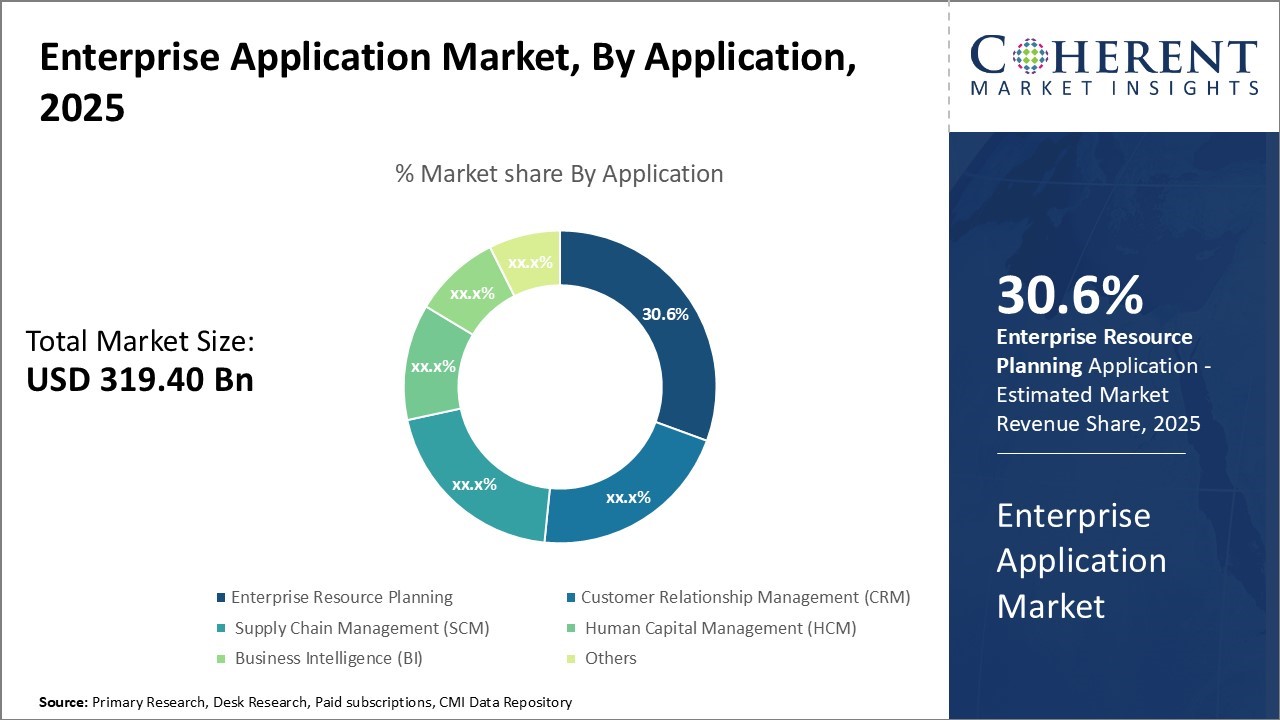Enterprise Application Market Size and Trends
Global enterprise application market is estimated to be valued at USD 319.40 Bn in 2025 and is expected to reach USD 509.88 Bn by 2032, exhibiting a compound annual growth rate (CAGR) of 6.9% from 2025 to 2032.

To learn more about this report, Download Free Sample
Key Takeaways
- Based on Application, the Enterprise Resource Planning segment is expected to lead the market with a 30.6% share in 2025, owing to broad utility across industries.
- Based on Deployment Mode, On-Premise segment is projected to dominate with a 47.5% share in 2025, supported by its ability of organization to install application.
- Based on Vertical, Manufacturing segment is expected to account for highest share of 30.3% in 2025, due to its strategic use.
- Based on Region, North America is expected to lead the market, holding a share of 41.8% in 2025, owing to the presence of large enterprises.
Market Overview
The enterprises application market comprises applications that help businesses automate various back-office functions related to accounting, project management, enterprise resource planning, and more. The enterprise application refers to a complex software system used by organizations to support business operations, enhance productivity and improve efficiency. There is a rising demand to improve complexity, scalability, requirements, security concerns and many more which can be optimized with the help of enterprise application. As it will offers a seamless workflow in a company,
Current Events and Its Impact
|
Current Events |
Description and its Impact |
|
Rapid Adoption of Cloud Computing |
|
|
Growing Cybersecurity Concerns |
|
Uncover macros and micros vetted on 75+ parameters: Get instant access to report
Role of Artificial Intelligence (AI) on the Enterprise Application Market
Integration of artificial intelligence into enterprise application holds the potential to transform business operations and gain competitive edge, which includes customer service, sales, cyber security and product development. Utilization of AI of focuses on automate tasks, improves workflows and enhance decision-making with various business functions.
In May 2025, SAP Sapphire conference, launched innovations and partnership that put the power of Business AI for every user, revolutionizing the work operation. This new AI innovation boost business productivity by up to 30%. This initiative is taken by partnering with perplexity, an AI-powered answer engine company.
Enterprise Application Market Insights, By Application: Enterprise Resource Planning (ERP) Dominates the Overall market owing to the Broad Utility Across Industry
The enterprise resource planning (ERP) segment is estimated to contribute the highest market share of 30.6% in 2025, owing to its widespread use across most manufacturing and service industries. ERP systems offer a suite of applications that encompass back-office functions including finance, human resources, supply chain and operations. The modular nature of ERP allows companies to customize their solution as per specific business needs. While ERP implementation requires substantial upfront investment, it delivers increased operational efficiencies, control and visibility across the value chain over the long term. ERP adoption is further bolstered by continuous vendor innovation addressing emergent technologies like cloud, analytics and mobility. Majority of large enterprises now leverage ERP as a centralized hub to streamline and optimize business processes globally.
In April 2025, studies show that Oracle has become the leading provider of ERP application in 2024, stilling a position that SAP had held since the early 1980s. According to Apps Run The World (ARTW), Oracle owes its new top position to the fast-growing Oracle Fusion Cloud ERP products for accounting, order management and other business-critical processes. This is further adding to the enterprise application market share.
Enterprise Application Market Insights, By Deployment Mode: On-Premises Segment Acquires the Largest Share
The on-premises segment is estimated to contribute the highest market share of 47.5% in 2024, owing to ability of organizations to install applications and databases on their premises servers as per discretion. On-premises solutions allow full control over mission critical data and its access. However, on-premises deployment necessitates large upfront capital investment in hardware procurement and ongoing maintenance. Cloud-based applications leverage pay-as-you-go commercial model and offer flexibility to scale services on demand. But perceived issues around data security and regulatory compliance restricted faster adoption of cloud modes, especially for sensitive operations. Hybrid models attempt to achieve best of both worlds through private cloud and public cloud integration.
In January 2025, Qualcomm Technologies, Inc., unveiled Qualcomm® AI On-Prem Appliance Solution, an on-premises desktop or wall-mounted hardware solution, and Qualcomm® AI Inference Suite, a set of software and services for AI inferencing spanning from near-edge to cloud. Together, they offer small and medium businesses, enterprises and industrial organizations to run custom and off-the shelf AI application on their premises.
Enterprise Application Market Insights, By vertical: Manufacturing segment Acquires the Largest Share
Manufacturing segment is estimated to contribute the highest market share of 30.3% in 2025, due to strategic use of applications across varied front and back-end functions. Manufacturing units rely on ERP for integrated management of plant maintenance, production planning, inventory, shipping and financial reporting. Adoption of supply chain management applications facilitates visibility and collaboration with vendors and suppliers. Furthermore, industry specific solutions address nuanced needs of discrete and process manufacturing. Mobility solutions also allow manufacturing managers access to real-time information on- the- go.
In May 2025, BEET, an AI-driven global industrial IoT platform for smart manufacturing, launched BEET Enterprise, an enhanced version designed to help manufacturers optimize performance at scale.
Regional Insights

To learn more about this report, Download Free Sample
North America Enterprise Application Market Analysis and Trends
North America dominates the global enterprise application market with an estimated market share of 41.8% in 2025. Significant presence of large enterprises across industries such as manufacturing, IT, healthcare and banking boosts adoption of enterprise applications. Organizations in the region emphasize on efficiency and innovation through automation of business processes. This has prompted many companies to invest in solutions that help gain better visibility and control over operations. With focus on improving user experience and productivity, there has been huge demand for next-gen enterprise apps featuring AI, predictive analytics and cloud-based delivery models. In June 2024, Automation Anywhere launched a new AI-powered automation system in the U.S., enabling companies to achieve 10x business impact by using AI agents to transform essential workflows. Strong economy, innovation focus and early traction for emerging technologies provide an ideal environment for vendors in the region. This further propels the enterprise application market share in the region.
Asia Pacific Enterprise Application Market Analysis and Trends
Asia Pacific has emerged as the fastest growing market for enterprise applications globally. Rapid digitization and industrialization and growing dependence on technology across enterprises drives the market growth. There has been increased focus on leveraging apps to gain strategic and operational advantages. Countries like China and India have witnessed enormous infrastructure growth with new enterprises being established at a rapid pace across sectors. This has opened huge opportunities for vendors offering cost-effective and scalable digital transformation solutions. Mobile-first mindset of users in the region has pushed adoption of cloud-based multi-device compatible apps. Vendors are localizing offerings and engaging more with system integrators to tap into rising demand from small and medium enterprises. The pricing models also consider the budget sensitivities of developmental markets, making solutions more accessible.
Enterprise Application Market Outlook Country-wise
The United States Enterprise Application Market Trends
The United States is the leading country for enterprise application due to strong economy, focus on innovation and a large number of small and medium-sized enterprises (SMEs) adopting this solution. Along with that, U.S. is a major hub for CRM adoption and innovation and has large number of tech companies that are well-judged by both consumers and industry professionals. In 2025, there were 1,535 CRM system Providers in the United States businesses.
India Enterprise Application Market Trends
India is experiencing a significant growth in the enterprise application market due to digital initiatives, increasing cloud adoption and a strong talent pool with skilled and affordable workforce. India has an expanding technology ecosystem and government support of the IT sector. India has a large pool of engineers and IT professions which elevate demand for elevate enterprise application. India IT industry has approximately 5.4 million people, including both IT professionals and engineers. According to ICD study, there are approximately 40% of Indian organization adopted cloud services in 2024.
Enterprise Application Market Driver
Digital Transformation and Cloud Adoption
In this digital era, organizations across various industries are under pressure to accelerate their digital transformation journey and cloud adoption. The breakneck pace of technology innovation and changing customer habits are forcing companies to fundamentally transform how these operate and engage with customers. There has been growing realization that legacy on-premise systems can no longer support the agility, scalability, and flexibility required to power digital business models. Many firms understand that a cloud-first approach is essential to enable new ways of delivering value, driving innovation, and gaining competitive advantages.
Adopting cloud-based applications allows organizations to optimize costs by transitioning from large upfront capital expenditures to pay-as-you-go operational expenses. It alleviates the need for huge initial investments in IT infrastructure and reduces the burden of maintaining servers, storage, databases, and other resources. Companies can avoid overprovisioning for peak usage and have near-infinite scalability on demand. Furthermore, cloud applications are accessible from anywhere through a browser, empowering employees with mobility and flexibility. This improves workforce productivity, collaboration and speeds up critical business processes.
Increasing Demand for Mobility and Remote Work Solutions
The accelerated shift to remote work has underscored the importance of cloud-based enterprise applications that facilitate an agile, distributed, and digital workforce. Upwork estimates that by 2025, around 32.6 million Americans—approximately 22% of the workforce—will be working remotely. With employees accessing systems from anywhere using various personal devices, there has been huge need amongst organizations to support a secure mobile workforce and optimize productivity outside traditional office settings. Vendors are witnessing tremendous interest in their mobile-first solutions for critical functions like sales, services, marketing, project management and finances.
Enterprises want applications that can consolidate disparate tools, improve collaboration internally as well as externally with partners and customers, and deliver unified experiences. Empowering employees with self-service access on any device is pivotal for business continuity, especially in times of uncertainty. Forward-thinking firms are choosing vendor partners and platforms that can address these needs through robust mobility offerings, social functionality, contextual assistance and analytics capabilities. This enables remote working at scale, ongoing customer engagements, virtual project execution and flexible work arrangements. This is further adding to the enterprise application market revenue.
Enterprise Application Market Opportunities
Growing Demand for Industry-Specific Applications
Growing demand for industry-specific applications can offer market growth opportunities. A one-size-fits-all approach is not feasible nowadays as the business needs and processes vary widely across sectors. Vertical industries like manufacturing, healthcare, transportation, and other require applications tailored to their unique workflows, technologies used, compliance standards and other domain specific requirements. Legacy systems in many verticals also need 8. This offer opportunity for both established vendors as well as new players to develop and offer industry-focused solutions. Products with functionalities designed for specific roles within an industry can address the challenges better while improving productivity. As industries undergo digital transformation, there will be huge demand for such vertical applications. Vendors will have to closely work with customers to deeply understand their circumstances and accordingly develop innovative solutions.
Market Players, Key Development, and Competitive Intelligence

To learn more about this report, Download Free Sample
- In May 2025, Docker Inc., a software containerization company, launched Docker hardened Images, a new service that curates a catalog of security-hardened, enterprise-grade container images that meet the toughest software supply chain challenges. Docker is designed with security at its core, offering users images that are minimal, continuously maintained and testes to meet enterprise compliance standards.
- In May 2025, IBM launched new hybrid technologies for scaling enterprise AI. It is designed to enable businesses to build AI agents with their own enterprise data. IBM estimates that over 1 billion apps will emerge by 2028, putting pressure on businesses to scale across increasingly fragmented environments. This requires integration, orchestration and data readiness.
- In June 2024, Oracle Corporation, a global leader in database software and cloud solutions, announced significant advancements in its low-code development platform, Oracle APEX. The latest version introduces the APEX AI Assistant, which streamlines app creation and helps developers rapidly produce feature-rich, large-scale, mission-critical applications. This innovative tool leverages artificial intelligence to enhance productivity and simplify the development process.
- In March 2024, SAP SE, a leading provider of enterprise software solutions, and NVIDIA a pioneer in graphics processing and AI technology, announced an expansion of their partnership aimed at providing enterprise clients with faster access to SAP's suite of cloud solutions and services, along with the transformative capabilities of data and generative AI. This partnership is designed to enhance the adoption of generative AI across SAP’s portfolio, enabling organizations to leverage advanced technologies for improved efficiency and innovation.
Market Report Scope
Enterprise Application Market Report Coverage
| Report Coverage | Details | ||
|---|---|---|---|
| Base Year: | 2024 | Market Size in 2025: | USD 319.40 Bn |
| Historical Data for: | 2020 To 2024 | Forecast Period: | 2025 To 2032 |
| Forecast Period 2025 to 2032 CAGR: | 6.9% | 2032 Value Projection: | USD 509.88 Bn |
| Geographies covered: |
|
||
| Segments covered: |
|
||
| Companies covered: |
Adobe, Inc., Epicor Software Corporation, Hewlett Packard Enterprise, IBM Corporation, Infor, Inc., IFS AB, Microsoft Corporation, Oracle Corporation, QAD Inc., Salesforce.com, Inc., SAP SE, ServiceNow, Inc., Sisense, Workday, Inc., Zoho Corporation |
||
| Growth Drivers: |
|
||
| Restraints & Challenges: |
|
||
Uncover macros and micros vetted on 75+ parameters: Get instant access to report
Analyst Opinion (Expert Opinion)
- The enterprise application market is at a pivotal juncture, driven less by traditional growth metrics and more by the urgent need for intelligent, integrated solutions that directly enhance operational agility and strategic decision-making. What stands out starkly is the accelerating adoption of AI-powered enterprise applications—platforms that are no longer just supportive tools but strategic enablers of competitive differentiation.
- Consider how companies deploying AI-driven ERP and CRM systems report a 30-40% increase in process efficiency and up to a 25% reduction in operational costs, according to recent Bain & Company case studies. This isn’t mere incremental improvement; it’s a seismic shift redefining enterprise workflows. Salesforce’s Einstein AI integration, for example, has enabled clients to boost sales conversions by up to 30%, underscoring the transformative impact of embedding AI directly into customer engagement platforms.
- Moreover, the surge in demand for low-code and no-code enterprise applications reflects a critical shift in who is driving digital transformation—moving from IT-centric to business-led initiatives. Microsoft Power Platform’s rapid growth, with over 10 million monthly active users, exemplifies this trend, empowering frontline employees to create custom apps that address unique operational challenges without waiting for IT cycles. This democratization is vital for enterprises facing the dual pressures of speed and customization in a volatile market.
- Apart from this, security and compliance have become non-negotiable pillars in enterprise application deployments. The rise of zero-trust frameworks embedded in enterprise SaaS solutions—highlighted by Okta’s 40% year-over-year increase in identity management deployments within regulated industries—reflects how applications must now proactively mitigate risk while enabling seamless access.
- In sum, the enterprise application landscape is no longer about basic functionality or incremental gains. It’s about embedding intelligence, fostering agility through democratization of development, and ensuring robust security as foundational imperatives. Companies that fail to adopt this holistic approach risk falling behind in an environment where every percentage point of efficiency or security matters profoundly.
Market Segmentation
- By Application Insights (Revenue, USD Bn, 2020 - 2032)
- Enterprise Resource Planning (ERP)
- Customer Relationship Management (CRM)
- Supply Chain Management (SCM)
- Human Capital Management (HCM)
- Business Intelligence (BI)
- Others
- By Deployment Mode Insights (Revenue, USD Bn, 2020 - 2032)
- On-Premises
- Cloud-Based
- Hybrid
- By Vertical Insights (Revenue, USD Bn, 2020 - 2032)
- Manufacturing
- BFSI (Banking, Financial Services, and Insurance)
- Retail and Consumer Goods
- Healthcare
- IT and Telecommunications
- Others
- By Regional Insights (Revenue, USD Bn, 2020 - 2032)
- North America
- U.S.
- Canada
- Latin America
- Brazil
- Argentina
- Mexico
- Rest of Latin America
- Europe
- Germany
- U.K.
- Spain
- France
- Italy
- Russia
- Rest of Europe
- Asia Pacific
- China
- India
- Japan
- Australia
- South Korea
- ASEAN
- Rest of Asia Pacific
- Middle East
- GCC Countries
- Israel
- Rest of Middle East
- Africa
- South Africa
- North Africa
- Central Africa
- Key Players Insights
- Adobe, Inc.
- Epicor Software Corporation
- Hewlett Packard Enterprise
- IBM Corporation
- Infor, Inc.
- IFS AB
- Microsoft Corporation
- Oracle Corporation
- QAD Inc.
- Salesforce.com, Inc.
- SAP SE
- ServiceNow, Inc.
- Sisense
- Workday, Inc.
- Zoho Corporation
Sources
Primary Research Interviews from the following stakeholders
Stakeholders
- Interviews with CIOs, IT heads, enterprise architects, cloud operations managers, software procurement leads, enterprise solution vendors, digital transformation executives, and DevOps managers across leading global markets.
Databases
- World Bank Enterprise Surveys
- OECD Digital Economy Outlook
- UN Comtrade Database (for software-related trade metrics)
- S. Bureau of Economic Analysis (IT services and software sectors)
- Eurostat – Information and Communication Technology Statistics
- Ministry of Electronics and IT (MeitY), India
- Directorate General of Commercial Intelligence and Statistics (DGCIS), India
- Korea Customs Service – Software and IT Service Exports
- Japan External Trade Organization (JETRO) – Software Reports
Magazines
- CIO Review
- Enterprise Tech Journal
- Computer Weekly
- Network World
- DevOps.com
- TechTarget – Enterprise Applications
- IT Pro Today
- Database Trends and Applications (DBTA)
Journals
- IEEE Transactions on Software Engineering
- ACM Transactions on Software Engineering and Methodology
- Journal of Enterprise Information Management
- Information Systems Journal
- International Journal of Information Management
- Journal of Systems and Software
Newspapers
- The Wall Street Journal – CIO and Technology Section
- The Economic Times – Enterprise IT & Digital Transformation
- The Hindu Business Line – IT & Cloud Services
- Financial Times – Business Technology Coverage
- Nikkei Asia – Enterprise Software and Cloud Adoption
- South China Morning Post – IT Business & Corporate Tech
Associations
- Object Management Group (OMG)
- Open Group (Enterprise Architecture TOGAF standards)
- International Telecommunication Union (ITU) – ICT Applications
- Institute for Electrical and Electronics Engineers (IEEE)
- Confederation of Indian Industry (CII) – IT & Enterprise Software Panel
- Japan Software Industry Association (JISA)
- European Telecommunications Standards Institute (ETSI) – Enterprise Interoperability
Public Domain Sources
- Ministry of Electronics and IT (MeitY), Government of India
- S. National Institute of Standards and Technology (NIST) – Enterprise Architecture Guidelines
- Ministry of Economy, Trade and Industry (METI), Japan – Software Sector Insights
- EU Digital Single Market Observatory – Enterprise IT Reports
- NITI Aayog – IT Infrastructure and Digital Economy Reports
- India Investment Grid – IT Sector
- Reserve Bank of India (RBI) – IT Services and Software Exports Data
Proprietary Elements
- CMI Data Analytics Tool, and Proprietary CMI Existing Repository of information for last 8 years
*Definition: Global enterprise application market includes software solutions that help large organizations modernize and streamline their operations. This market provides core business applications like ERP (Enterprise Resource Planning), CRM (Customer Relationship Management), HCM (Human Capital Management), SCM (Supply Chain Management) and other solutions that improve a company's efficiency, productivity and business processes.
Share
Share
About Author
Monica Shevgan has 9+ years of experience in market research and business consulting driving client-centric product delivery of the Information and Communication Technology (ICT) team, enhancing client experiences, and shaping business strategy for optimal outcomes. Passionate about client success.
Missing comfort of reading report in your local language? Find your preferred language :
Transform your Strategy with Exclusive Trending Reports :
Frequently Asked Questions
EXISTING CLIENTELE
Joining thousands of companies around the world committed to making the Excellent Business Solutions.
View All Our Clients


